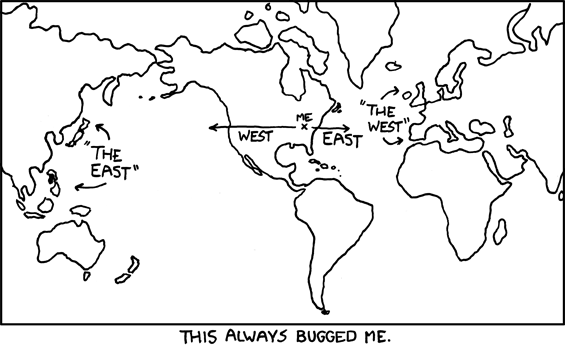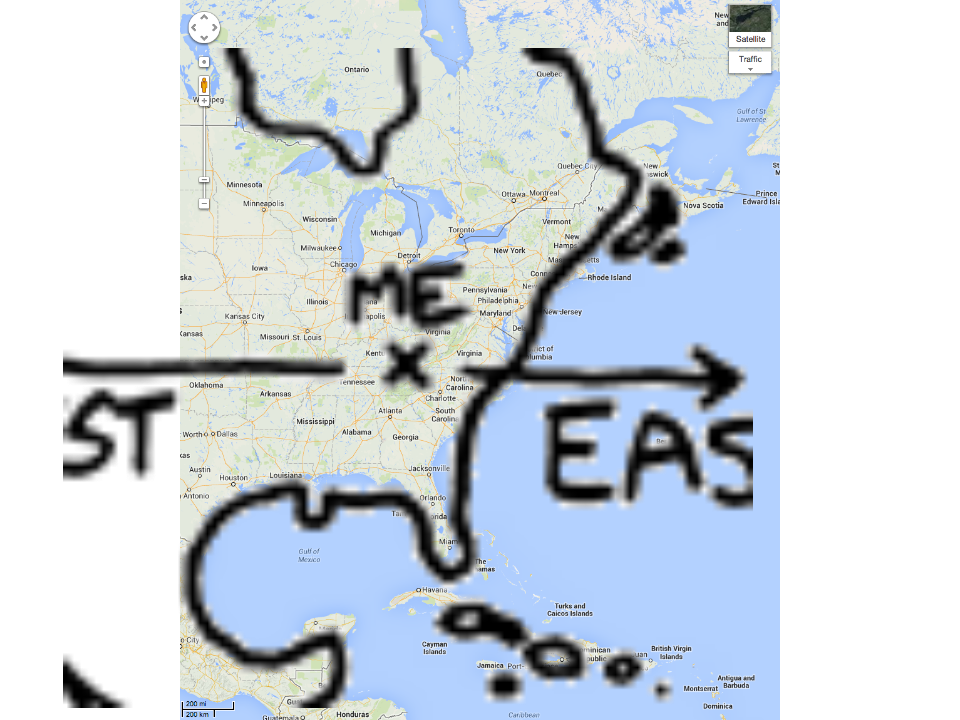503: Terminology
| Terminology |
 Title text: Also, is it just me, or do Japan and New Zealand look suspiciously similar? Has anyone seen them at a party together? |
Explanation
| |
This explanation may be incomplete or incorrect: Where is the X? If you can address this issue, please edit the page! Thanks. |
This comic shows a map of the world. The X in the center, labeled "ME", indicats Randall's location in the U.S., and two arrows point west and east from it. The map uses a format, popular in America, which places the American continents centrally, therefore splitting Asia, (parodied by "you-cut-asia-in-half"). The comic then shows Europe with the title "The West" as it is commonly referred to, despite being located to the east of Randall, and vice versa for Asia. Randall is therefore annoyed with the common terms "The West" and "The East" referring to locations east and west of him respectively.
The east and west are defined in geographical term as a reference from zero Longitude also known as the Prime meridian which runs though Greenwich, London, United Kingdom. Western Hemisphere and Eastern Hemisphere are derrived from that reference of centering a map around the Prime meridian.
The term "The East" and "The West" has then later been expanded or (mis-)appropriated to include references to trade and political alliances.
The fact that zero longitude is running though London is an artifact of that the British was primary force in exploring the world at the time of drawing the modern maps of the world, and hence most maps was created by the British, with England being the center. The east and west should simply be viewed as a reference to map coordinates and not as relative to where you are as suggested by the comic. In short America-centered map does not redefine "East" or "West" anymore than Australian up-side-down Reversed map maps redefining what is North or South.
The convention of orienting maps with north at the top and west at the left was started by the greek geographer Ptolemy. In his work Geography (Ptolemy) he introduces the first coordinate system with latitudes and longitude. Randall shows some other possible map orientations in 977: Map Projections.
The title text comments on the similarity in shape of New Zealand and Japan, and suggests that one may in fact be the other in disguise. The similarities are partly explained by both forming as volcanic island chains.
Where is "X"
Transcript
- [Map of world with North America centered. An "x" is placed near east coast. Asia is labeled "The East" and Europe "The West."]
- "The East" <- West x (me) East -> "The West"
- This always bugged me.
Discussion
Well, sitting in Europe, the East is in fact east and the West is in fact west of me. It's just a term made from an European point of view and has settled over time. The main problem is that east and west should be used as relative directions but are used absolute. (Contrary to north and south which can also be used absolute). --83.243.48.2 12:18, 30 April 2013 (UTC)
- I'm still accustomed to the use of the Pacific Ocean as the geographical split, centralising the Atlantic Ocean. However, since the UTC boundary sits east of the Atlantic, perhaps the East and West hemispheres should be reversed to match.
- Do we have enough dumptrucks to handle this formidable task? Thokling (talk) 08:35, 25 September 2013 (UTC)
- So what? The International Date Line sits within the Pacific. Also, for the reasons mentioned above (east and west being relative), I would refrain from using the terms eastern and western hemisphere. --SlashMe (talk) 14:17, 25 September 2013 (UTC)
- It's not only point of VIEW. Our civilization is based in Europe. Europeans first discovered and then conquered rest of world (doesn't matter if the people already living there wanted to be discovered or not). "West" is what was discovered when sailing to west from Europe, "east" is what was discovered when sailing to east. Americans (especially citizens of USA) sometimes forget they are (mostly) NOT native of America, but immigrants from Europe.
- Also, in Europe itself, the division between "east" and "west" was set at end of world war II, at Potsdam Conference, and I'm sure noone cared for geography there. -- Hkmaly (talk) 12:13, 13 November 2013 (UTC)
- Actually, I think that by now most people in America are natives. It has been several generations since the discovery of the Americas by the Europeans, so even though they are descendants of Europeans most current inhabitants of the Americas were born there in the Americas. Being born there is what makes you native to it, otherwise there would be no native Americans at all, since the inhabitants of the Americas can be roughly divided into, in reverse chronological order of inhabitance, descendants of Africans, Europeans and Asians (that is, descendants of Asians were the first to inhabit America). Tharkon (talk) 02:35, 13 February 2014 (UTC)
- Actually, both Europeans and Asians originally came from Africa. :P 173.245.54.85 19:38, 4 March 2020 (UTC)
- I mean, the whole comic is based around about how it doesn't make sense if you live in America. Beanie (talk) 09:53, 30 March 2021 (UTC)
- Where is "X"
The map seems to be using the either the Gall stereographic projection or the Mercator projection, which is also used by Google Maps. However, the drawing does not match up with the standard projection used by Google Maps -- Better people may be able to find a projection which more closely align with the drawing.
Moved from explain page. --Dgbrt (talk) 21:39, 12 December 2013 (UTC)
Well, Randall did say in his What If? book that he did grow up in Virginia (the "flyover state" section of the book), so maybe he still lived around that point in 2008. And according to the X, my fact is correct. From what I can see. --JayRulesXKCD (talk) 16:33, 14 September 2016 (UTC)
I live in New Zealand and have been to japan so I can confirm that they are indeed different countries 162.158.176.47 (talk) (please sign your comments with ~~~~)
- How can you be sure that New Zealand did not just move very fast while you were on plane? 162.158.238.70 11:05, 6 May 2017 (UTC)
Well, as a European this has bothered me as well. After all, the American East coast is to the West of us... while the West coast is far closer to China than to Europe (i.e. far closer to the East than to the West). I tend to confuse the two a lot... As a compromise, I suggest calling all three coasts the East/West coast to resolve any and all confusion and ambiguity. --162.158.88.212 10:36, 18 April 2018 (UTC)
- To further confuse things, I will also point out that the easternmost AND westernmost points of the US are both in Alaska: WorldAtlas L-Space Traveler (talk) 01:48, 2 September 2022 (UTC)
Randall comments on how New Zealand and Japan look similar, and the superhero comparison made is... Spiderman? Spiderman wears a costume that covers his entire body. Superman would be far more fitting. Changing this.
-Sensorfire (talk) 02:25, 15 August 2018 (UTC)

